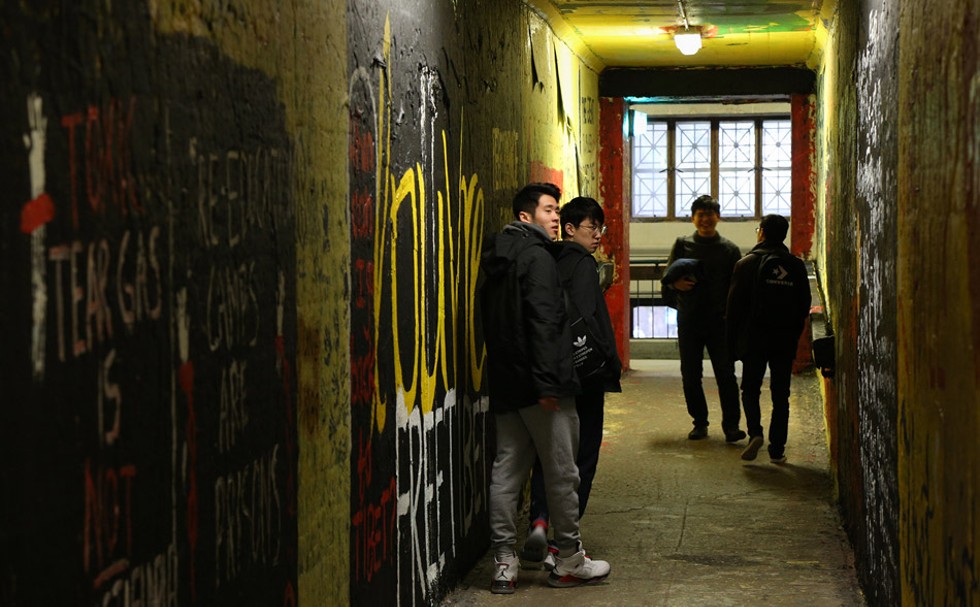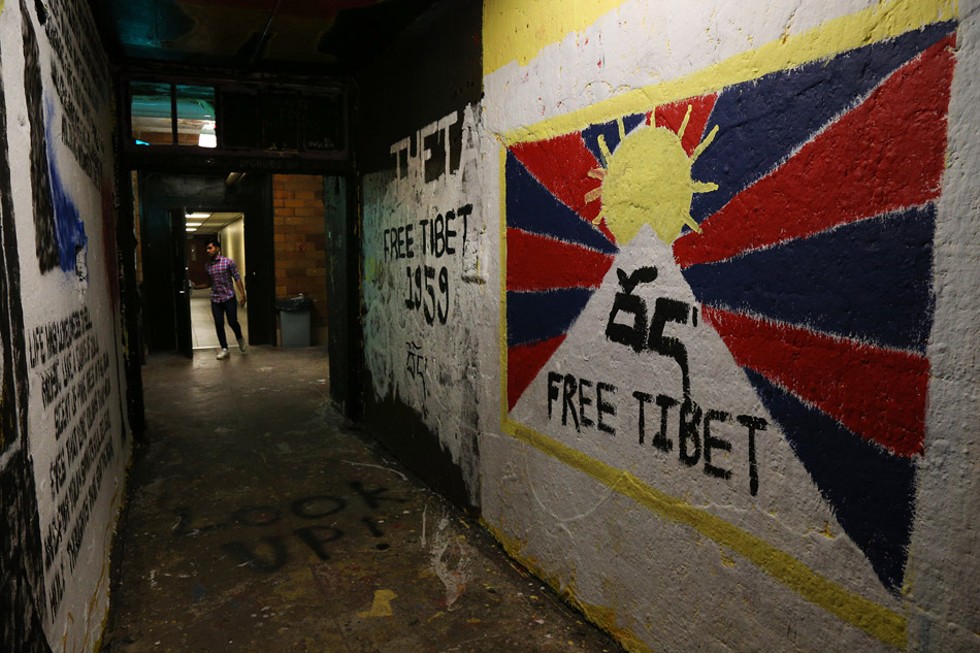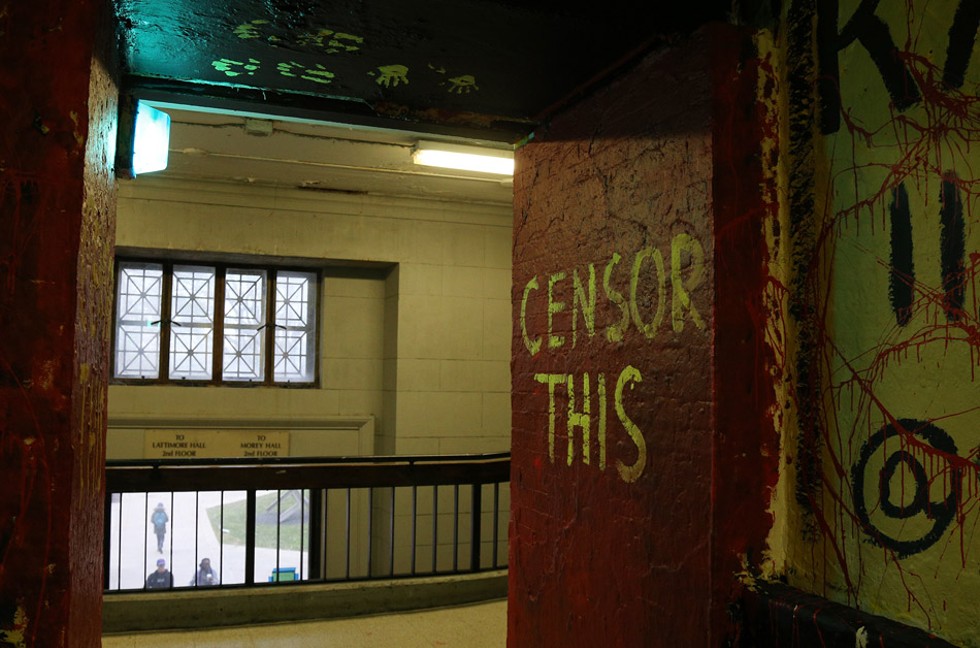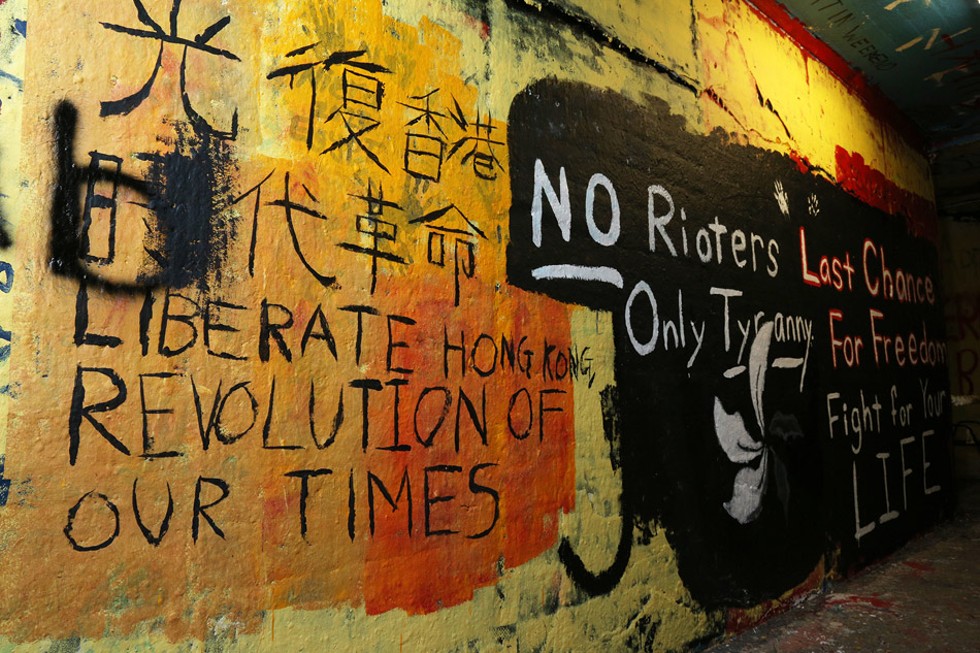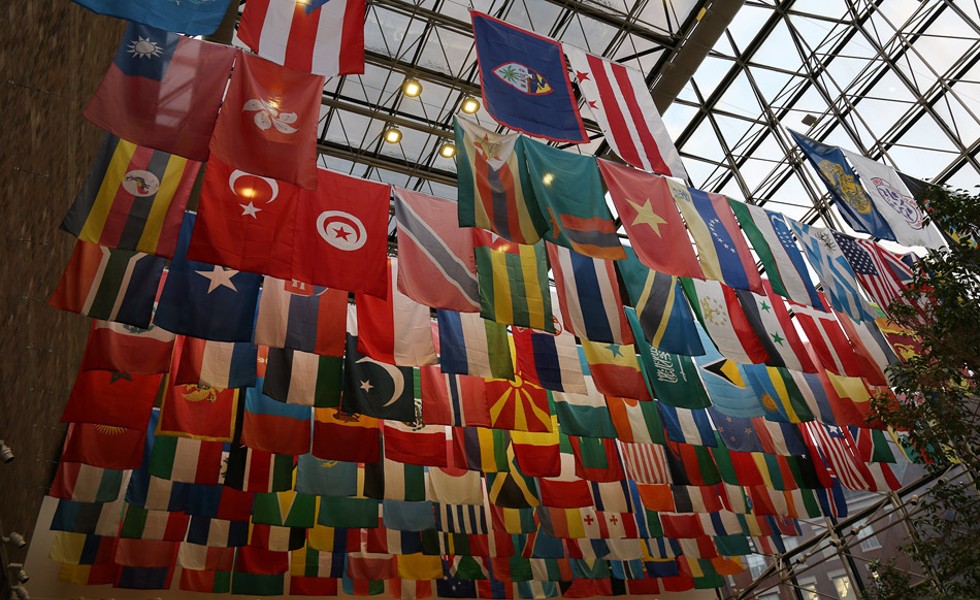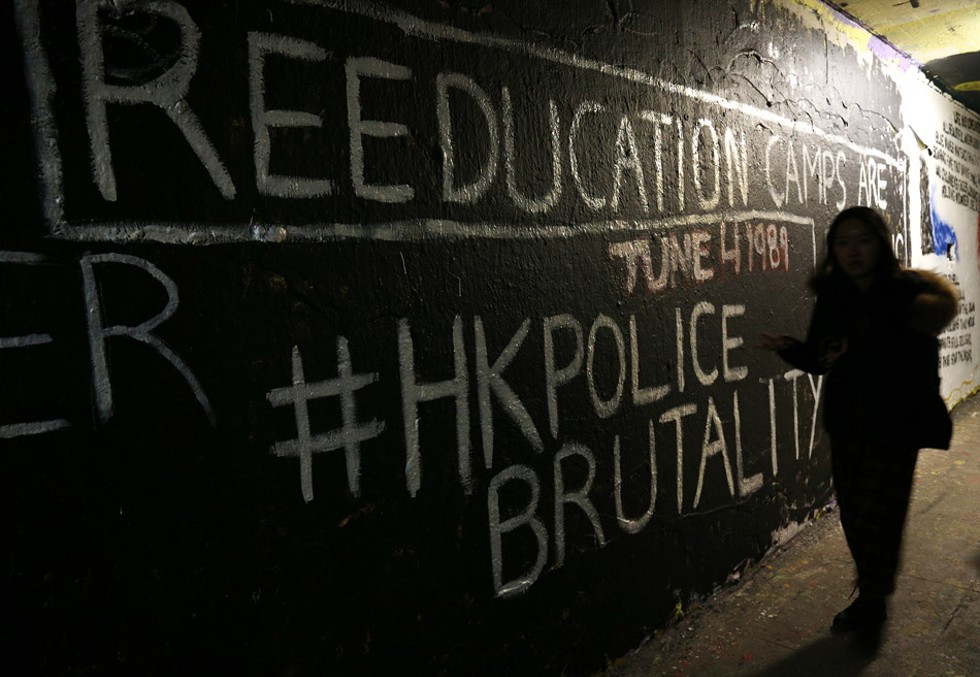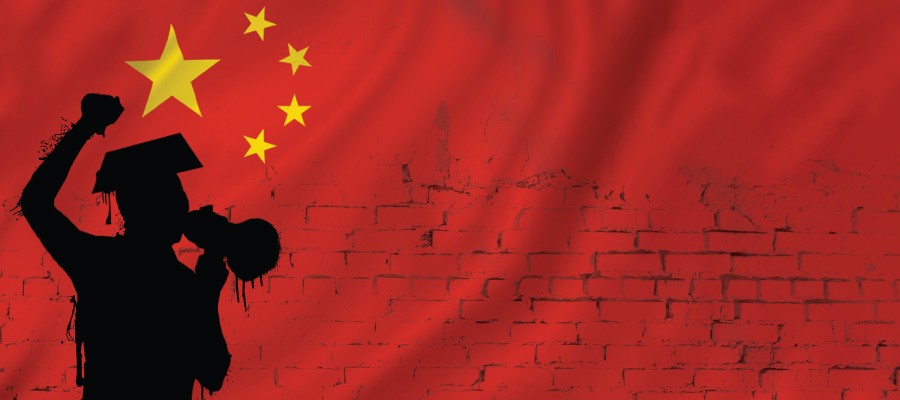
[
{
"name": "500x250 Ad",
"insertPoint": "5",
"component": "15667920",
"parentWrapperClass": "",
"requiredCountToDisplay": "1"
}
]
The dozens of students who gathered in a stretch of the University of Rochester's elaborate tunnel system on a recent Sunday night wore all black, save for the blue surgical masks over their mouths.
They were in battle fatigues for the latest salvo in a series of conflicts on campus that had been simmering for months over opposing views on all things China – the Hong Kong protests, the status of Taiwan and Tibet, democracy, and human rights.
They came armed with paint, brushes, and rollers and executed their mission in relative silence, each targeting a patch of concrete wall in the tunnel spanning hundreds of feet under the Eastman Quadrangle in the center of campus.
Painting the tunnel has been part of campus culture for nearly 50 years. Student groups mostly put brush to wall to advertise upcoming events. But every so often, the tunnel becomes a battleground for political discourse.
Four days earlier, a group of unidentified students covered nearly the entire tunnel with colorful messages supporting the Hong Kong protests, backing autonomy for Tibet and Taiwan, and condemning the ethnic cleansing of Uighurs in Xinjiang. One section depicted a Taiwan flag beside a countryball of Hong Kong and a flag of East Turkestan, the region from which Uighurs hail.
A day later, it had all disappeared
Students mobilized by the Chinese Students and Scholars Association - a Chinese student organization with close ties to the Chinese government and with branches at dozens of schools around the country - painted over the art with their own messages portraying China as a loving and peaceful nation.
"I was like, 'How could you do this?'" sophomore Andrew Vascellaro said. "This is support for oppressed peoples and you just come in and basically contribute to oppression."
He was among the dozens of students who had come to the tunnel to set things right by recreating the original artwork.
"I came when the tunnels were first painted with all the messages and I thought that was so amazing," Vascellaro said, angling his elbow so his brush wouldn't drip white paint on the floor.
The news of the back-and-forth "cover ups" hit the university's popular meme pages online, which, like the tunnels, have become avenues for political expression. Debates raged in the comments sections. Students from mainland China who took offense to the initial paintings asked why theirs was the only country being called out. Tangential threads of pushback ensued.
More than 600 students signed a petition that cast the unidentified student artists as victims of Chinese oppression and refugees of state-sponsored violence, and demanded the university administration condemn the "censorship" and what the petition called "past offenses."
The petition went further to call for the CSSA to be barred, and for the university administration to hang the flags of Taiwan and Hong Kong in a section of a campus lounge reserved for flags representing the make-up of the student body.
The administration had recently relocated the flags, which hung in a section of Hirst Lounge in the Wilson Commons building reserved for "Flags of UN Recognized States," to another section reserved for "Other Countries and Regions."
CHINESE STUDENTS SURGING
A war of words at the University of Rochester over paintings and flags is a far cry from black-clad students hurling gasoline bombs and bricks at the riot police storming Hong Kong university campuses. The U of R is not under siege. The sanctity of higher education here is intact.
But the tensions at U of R linked to the broad conflict overseas illustrates how the turmoil in China can play out on American college campuses, where students from China and its sphere of influence are studying in greater numbers. Similar disputes have surfaced on campuses across the country, from Boston University to UCLA.
In 2018-19, colleges in the United States enrolled a record 1,095,299 foreign students, a nominal uptick over the previous year but an increase of roughly 50 percent from the beginning of the decade, according to the latest "Open Doors" report from the Institute of International Education.
Chinese students lead this surge, accounting for almost 34 percent of foreign students at American colleges. In other words, one of every three international students in the United States holds a Chinese passport.
At U of R, the rate is much higher. The university reports hosting 4,250 international students, who account for about a third of the student body. More than half of those students – 2,270 – hail from China.
In October, China Daily, a state-run English-language newspaper published in China, reported the U of R plans to recruit more Chinese students "to enrich their international experiences via specialized degrees." The newspaper quoted the dean of the Simon School of Business, Andrew Ainslie, as saying the school has been working hard to help applicants through the visa process.
TIBET AS A FLASHPOINT
Tensions on campus first rose in September when College Republicans advertised an upcoming event: "Tibet dialogue: Democracy-in-Exile and the future of Tibet." The group aimed to showcase Tibet as a model of American democracy abroad and the event featured Ngodup Tsering, a representative of the Dalai Lama, as the keynote speaker.
"The Dalai Lama supports freedom of speech and freedom of religion which are values that are central to the Republican party," College Republicans president Anthony Pericolo said.
In China, however, the "Tibet question" is fraught with disagreement over the region's right to sovereignty. Many Tibetans favor independence, and resent the erasure of their culture, religion, and language under Chinese government policies. Meanwhile, many in mainland China consider Tibet as rightfully belonging to China.
Sampson Hao, president of the Chinese Students' Association, a campus student cultural group distinct from the CSSA, emailed university administration officials to voice concern about the event.
"The speaker is here to talk about a controversial topic that belittles the Chinese government and the people," his email read. "How would audiences with limited understanding about China view the Chinese community after listening to the speech? Imagine: your understanding of the culture and the history of the United States is a blank sheet of paper, and someone gives an agitative speech on the holding camp of Japanese by U.S. in California during World War II after Pearl Harbor. Then what is your reaction towards the U.S.? Hostility is aroused so easily when you are innocent to the whole picture."
Underscoring Hao's objections lay themes that would prove to resonate throughout the conflicts that followed: Friction between people from different countries holding different values, and the desire to be heard.
Hao criticized the College Republicans for casting the event as "a dialogue" when it only represented one viewpoint - a fact the president of the College Republicans has since unapologetically acknowledged.
"I'll be honest, the event was kind of one-sided," Pericolo said. "We're College Republicans. We wanted to represent the American values that the Dalai Lama supports."
Hao contrasted the event to another on the Hong Kong protests co-hosted weeks earlier by his organization and the Hong Kong Students Association, which opened the floor for students and invited them to speak their mind.
Pericolo denied CSA's request to see the panel questions or give a speech at the event, but allowed CSA to submit questions for the Q&A session. Hao said CSA tried to schedule a meeting with the College Republicans. When that failed, CSA did not pursue the matter further.
But someone else did.
Soon, flyers advertising the College Republicans' event with a decidedly pro-China stance began popping up around campus. The flyers renamed the event, "Tibet: Freedom or Terrorism?" and depicted a grisly image of a man engulfed in flames - some Tibetans have practiced self-immolation to protest Chinese rule.
The flyers were the handiwork of a student, Yifan Xu. He attended the event and during the open session, when the audience could ask questions, laid out his arguments on why Tibet needed to remain part of China.
His views were greeted with widespread disapproval. One audience member interrupted Xu, shouting, "Don't rely on Wikipedia!" The mic runner shook his head as Xu ran over his allotted time.
Tensions were high, but did not boil over. An organizer of the event, graduate student Se Hoon Kim, even shook Xu's hand afterward. "That would have been the end of it," Kim said.
Then the Starbucks incident happened.
THE 'STARBUCKS INCIDENT'
Recalling the incident, Kim sighed, removed his glasses and rubbed his face.
At the time of the Tibet event — and by coincidence — some Tibetan monks were in town visiting with members of Rochester's Nepalese Buddhist community. Kim, who has connections to representatives of the Dalai Lama, invited the monks to U of R to meet Tibetan students.
While the monks and some students discussed meditation and school over coffee at a campus Starbucks, a Chinese student placed a sign near them that read: "TIBET IS PART OF CHINA."
"What are you trying to instigate?" Kim recalled asking the student."Why are you doing this?" Feeling his guests were not welcome, Kim escorted the monks out.
A Facebook post went up within hours, saying that Tibetan monks had been "harassed and chased out of Starbucks." Uproar in the comments section swiftly ensued. Xu later published a different account of the incident that claimed Kim ripped up the sign and threatened the student. His post garnered hundreds more comments.
Hao, president of the CSA, said his group didn't have a hand in the Starbucks incident.
But he said that Chinese students were beginning to feel unsafe on campus and that he feared another upcoming event organized by the College Republicans, this one on the persecution of Uighurs in China, could result in hostility against Chinese students.
Uighurs are a minority Turkic ethnic group, are largely Muslims, and their persecution by the Chinese government has been well documented.
Hao sued the College Republicans in campus court to push the group to modify its event on the Uighurs. When word of the suit was leaked online, which happened within hours, the College Republicans promptly filed a countersuit and called for an investigation into the CSA, which it accused of colluding with Tibet agitators.
Both groups later dropped their suits, but the publicity from their dispute had the ancillary effect of making the Uighur event more popular. Hundreds of people packed the venue.
VALUES IN CONFLICT
Anthropology professor John Osburg, who studies contemporary China, said the recent events have pitted U of R's values against each other, as the campus community strives to understand how people and groups can speak freely without disrespecting cultures.
Not helping matters, Osburg said, are barriers to having productive conversations about China's politics. One of them is philosophical. Historically, Osburg said, mainland China has not held the same views on human rights as the west. China's dominant philosophy, Confucianism, emphasizes obligations and duties that exist within certain relationships: parents to children, husband to wife, ruler to subjects.
This philosophy also emphasizes the wellbeing of the community over that of the individual, and a strong sense of identity between individuals and their country. Osburg said Chinese Communist Party responses to Western critiques are often framed as attacks on both the government and the people.
As Xu put it: "You have been attacked if the group has been attacked."
On-campus stereotypes of Chinese students, often based on the words and actions of a few, can also cause disagreements to get ugly, particularly in social media comment sections.
Xu recalled being surprised by the aggressive responses to his post about the Starbucks incident. He described watching it rack up over 200 comments in just a few hours, with some respondents calling him blind or brainwashed.
"It was the worst feeling," Xu said.
But the wounds of the Starbucks altercation have also been slow to heal for some students. None Gongyal, who was at Starbucks that day and had been blessed by the Tibeten monks with a ceremonial scarf, said he felt the same tensions at U of R that he felt in his native Tibet.
"Now I feel like I'm also under threat by the Chinese government even in a country like this," he said.
FLAG DISPUTE
In mid-November, a few weeks after the Uighur event, the university moved the Hong Kong and Taiwan flags in the Hirst Lounge from the main body of flags to an area reserved for countries and regions not recognized by the United Nations.
Dean of Students Matt Burns explained that the university last year adopted the UN list of member nations - of which Hong Kong and Taiwan are not part - as its criteria for the placement of flags in the lounge. He said the two flags were moved for International Education Week, which began November 18.
But the timing was viewed by many on campus within the lens of the China-related conflicts and added to what pro-Hong Kong, pro-Taiwan, and pro-Tibet students saw as a barrage of slights over the course of the semester.
"There's a very strong Chinese government influence on campus it feels like," said Amber Hu, a student from Taiwan. "It just feels very oppressive and now the U of R is doing this."
A few weeks earlier, news broke that the Eastman School of Music, part of the university, agreed to go forward with an orchestral tour of China despite that country's refusal to grant visas to three South Korean members of the orchestra.
The school later reversed course and canceled the tour after an outcry by students, alumni, and the wider Rochester community, with many critics accusing the university of bowing to China.
Warish Orko, who helped paint the first set of tunnel murals, said he did so to support students who felt isolated by the administration's lack of response to the incidents.
"It makes victims feel invisible, like they don't matter," Orko said.
Last week, Burns and another dean, Jeff Runner, issued a joint statement addressing the flag flap that reaffirmed the university's neutrality on recent China-related tensions. The statement signaled a possible end to the flag display, which has hung since 1994 and has been a source of controversy for years.
"I am concerned for our students from Hong Kong whose loved ones are in a difficult struggle," Burns said in an interview, adding that he was also concerned for mainland Chinese students. "They're starting to feel frustrated, they feel like they don't belong here."
NO ADMINISTRATIVE INTERVENTION
Burns said none of the disputes on campus to date warranted administrative intervention, and attributed the vitriol to a small number of students.
He added, though, that free speech is a "messy enterprise."
"The language may have been offensive to some. But you get to say offensive things from time to time," Burns said. "We have tried to impose as few limits on freedom as possible because without it we would cease to be the culture that we are."
Instead, Burns said, students need the tools to handle uncomfortable discourse. He encouraged students to reframe online disagreements by responding to hurtful comments with inquiry instead of condemnation. For example, "Why would you say that?" instead of "Get out!"
There have been olive branches amid the tension.
On Monday, the university's Hong Kong Students Association set up a display under the Hirst Lounge flags hoping to defuse friction around the tunnel painting back-and-forth, particularly a pro-Hong Kong mural.
Many Chinese students had felt offended and targeted because the mural had been written primarily in Chinese.
But the association hoped to show that the artist had written in traditional Chinese — which is widely spoken in Hong Kong — and that the messages contained no hate. They only expressed support for Hong Kong students and Hong Kongers abroad.
The association's president, Selina Xu, said she hoped the display could help heal the divided community. She said she was already seeing signs of this, referencing a student who had spent a long time reading through the interpretation of the wall and recent events.
"He was really confused and he came with a lot of questions," she said. "That conversation helped him to know more about what happened on campus and what is really happening in Hong Kong."
Efua Agyare-Kumi is a third-year student at the University of Rochester majoring in English and political science.

